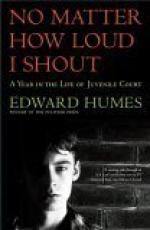
|
| Name: _________________________ | Period: ___________________ |
This test consists of 15 multiple choice questions and 5 short answer questions.
Multiple Choice Questions
1. What caused Chuck and Ada’s family to become much less happy with Peggy Beckstrand’s work on the Ronald Duncan trial in Part 3, Chapter 13?
(a) A memo that explained the culpability of the victims.
(b) A news story about the funding for the case.
(c) A news article criticizing the immunity agreement with Jason.
(d) A mayoral presentation that showed money on the trial was out of budget.
2. Author Humes explains two cases involving Judge Dorn’s reform in the juvenile justice system in Part 2, Chapter 12. The bad case example came with whom?
(a) Christopher Jones.
(b) Michael Anderson.
(c) James Peterson.
(d) Jason Watts.
3. What former juvenile prisoner continued gang-banging even after being blinded by bullets in Part 2, Chapter 11?
(a) Virginia.
(b) Rita.
(c) Sheena.
(d) Latoya.
4. Elias was sent to CYA but disobeyed orders so that he would be sent to jail and would be able to kill whom, according to the author in Part 2, Chapter 11?
(a) The father who beat him.
(b) The uncle that molested him.
(c) The man who murdered his grandmother.
(d) The man who shot his friend.
5. What lawyer represented John Sloan in Part 3, Chapter 16?
(a) Mary McCarthy.
(b) Michelle Sangh.
(c) Rosa Diaz.
(d) Angela Oh.
6. What was the fifteen-year-old pregnant girl with the teardrop tattoo charged with in Part 4, Chapter 18?
(a) Burglary.
(b) Theft.
(c) Murder.
(d) Arson.
7. Sister Janet is described as writing what in order to help the boys in Juvenile in Part 2, Chapter 10?
(a) Short stories.
(b) Poetry.
(c) Sheet music.
(d) Screen plays.
8. According to the author in Part 4, Chapter 18, who won passage of his proposal for a law that created a statewide task force to reinvent the Juvenile Court in California?
(a) Gil Garcetti.
(b) Ronald Duncan.
(c) Buddy Rogers.
(d) Bill Clinton.
9. Roy Sukoda was attempting to figure out a profile for what in Part 2, Chapter 9?
(a) The “24 percenter.”
(b) The “9 percenter.”
(c) The “16 percenter.”
(d) The “35 percenter.”
10. How many known members were there belonging to the 900 street gangs in Los Angeles County in 1994, according to the author in Part 4, Chapter 18?
(a) 45,000.
(b) 150,000.
(c) 90,000.
(d) 300,000.
11. How many kids were estimated in the Los Angeles Unified School District in 1994, according to the author in Part 4, Chapter 18?
(a) 640,000.
(b) 250,000.
(c) 950.
(d) 700,000.
12. Who refused to recall his sentence for George Trevino in Part 4, Chapter 18?
(a) Judge James Peterman.
(b) Judge John Hamilton.
(c) Judge Sarah Marshall.
(d) Judge Philip Hickok.
13. In overreaction to hearing one of her parolees was shot, who did Sharon Stegall have locked up in Part 2, Chapter 11?
(a) Rodger.
(b) Peter.
(c) James.
(d) Randy.
14. Who challenged the testimony of the prosecution’s key witness in Part 3, Chapter 13?
(a) James Cooper.
(b) Peter James.
(c) Michael Kennedy.
(d) Bobby Williams.
15. What is the name of the boy who is caught in connection with a series of some of the most brutal murders in LA County in Part 3, Chapter 13?
(a) Marcus.
(b) Rodrigo.
(c) Jose.
(d) Hugh.
Short Answer Questions
1. Who graduated from probation camp with honors after 8 months and was attending Los Angeles City College in Part 4, Chapter 18?
2. Where did Geri Vance hope to be sent so that he could get a college degree while in lock-up in Part 2, Chapter 11?
3. What is the title of Part 4, Chapter 18?
4. According to the author in Part 3, Chapter 16, when kids are arrested for violent crimes they what percentage chance of paying serious consequences?
5. Sister Janet pleaded against the mother of what victim in order to have Elias tried as a juvenile in Part 2, Chapter 10?
|
This section contains 560 words (approx. 2 pages at 300 words per page) |

|




